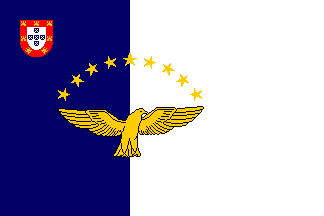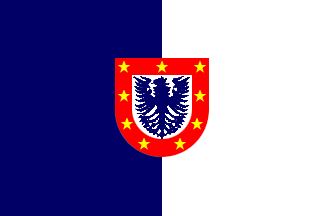António Martins, 24 Feb 2004

Last modified: 2014-06-29 by klaus-michael schneider
Keywords: azores | açores | star: 5 points (golden) | stars: arc | stars: 9 | hawk | goshawk | buzzard | anthem |
Links: FOTW homepage |
search |
disclaimer and copyright |
write us |
mirrors

Azores has a total area of 2335 km², and a population
of 237 315 inhabitants as of 1990 (239 480 as of 1990), living
in 9 islands encompassing
19 municipalities.
António Martins, 24 Jul 2001
The Azores flag consists of a 3:2 bicolour of blue and white, being the
blue field, at the hoist, two fifths of the flag’s area. Over the
division, and extending horizontally about half of the flag’s width is
a wingspreaded golden goshawk, under an arch of 9 golden stars, extending from
one wingtip to the other. In the honour point a white shield with a cross of
five blue eschuteons, each charged with a saltire of five white bezants, and
with a red border charged with seven golden castles.
António Martins, 08 Sep 1997 and 12 Dec 1997
Is there not a white edging around the Portuguese arms on the flag of the
Azores?
Christopher Southworth, 24 Feb 2004
At least the national flag has such a “lining” (I’m
not calling it a fimbriation because it has no heraldic meaning per
se).
António Martins, 25 Feb 2004
That may be facultative. I’ve seen a lot of flags that seemed not to
have it, but I’ve also seen a few that seemed to have it. In any case,
I can’t be sure. You see, that fimbriation would be so small in that
flag that it becomes practically irrelevant and invisible at some distance,
and quite difficult to spot in TV pictures (the vast majority of my sightings),
even when looking at good shots of big flags.
Anyway, I would guess that some flags would be produced with it, while
others will come out without it, just as it happens with the
national flag. Legally, though, it should have it,
because that is part of the portuguese shield and there’s nothing in the
azorean flag definition that explicitly strikes
that element out.
Jorge Candeias, 28 Jul 2004
According to recent reports in Lusovex, the
flag of Azores is being increasingly standartized to very very dark blue
(B+++ ![]() , like
UJ’s roundel blue). Earlier lighter
variations (which were never really light, just lighter than this one) are
almost inexistent these days. Example of this, contrasting with the (dark
enough) shade of the EU flag, on this
on
line photo (©DN).
, like
UJ’s roundel blue). Earlier lighter
variations (which were never really light, just lighter than this one) are
almost inexistent these days. Example of this, contrasting with the (dark
enough) shade of the EU flag, on this
on
line photo (©DN).
António Martins, 24 Feb 2004
The meaning is clear:
Interesting that the Azores as a whole use the old
monarchist flag as the basis of their own: According to
[mch85], p.135, «The blue-and-white of
the flag is derived from the former royal Portuguese
flag, and it is also linked with the flag of the
Azores Liberation Front which favoured
autonomy.» Are the Azores known as a hotbed of monarchism in
Portugal?
Roy Stilling, 29 Sep 1996 and 02 Dec 1997
Not really. The reasons for keeping the monarchist design are deeper than
that. The pro-autonomy movement was born in Azores before the revolution that
ended the monarchy in Portugal, and it is based on a flag that was first
hoisted in the island Terceira, and later, after
a civil war, became the Portuguese national flag.
The autonomist movement just replaced the
Portuguese arms in the center of the flag with a kind
of hawk that refers to the name of the archipelago. When autonomy was granted
in about 1976-77, they just added a lesser Portuguese
arms to the canton to the historical pro-autonomous flag.
Jorge Candeias, 03 Dec 1997
From a leaf of a stamp catalogue on a stamp issued in a two-stamp series on the flags of portuguese autonomous regions (Azores and Madeira), text by Jerónimo Cabral:
The Azorean flag, with its dark blue and white colours and having in the center «a flying goshawk with a stylized naturalist form, in gold», topped by nine stars and with the national coat of arms placed in the upper corner close to the pole, has deep historical roots dating back to late October 1897, when, as can be read in news published in the daily press of the time, for the fist time was hoisted the blue and white flag «definitively adopted to be the symbol of the Azorean administrative Autonomy».
Created to become a mark characterizing the campaigns for autonomy which broke out at the end of the last century in the Azores, the flag of the Administrative Autonomy, although never made legal, was never forbidden either, and in spite of having suffered alterations in the course of popular use, it always maintained the blue and white colours and the symbols of the goshawk and the nine stars.
Moreover, the goshawk already appears in 1582 in coins ordered to be minted by Dom António, Prior of Crato (self-declaired king, against the Spaniards); the same goshawk also appears in a map of Angra do Heroísmo, drawn in 1595 by Jean Hugues Linchosten.
The flag of the Azores, created by Regional Decree No. 4/79/A, of April 10, 1979, keeps the blue and white inherited from the colours of the National flag at the end of last century, which «in turn reproduced the heraldic colours of Portugal», with the goshawk, symbol of the Azores, supporting on its wings nine stars, symbol of the nine islands which comprise the Region; finally, the national coat of arms was added, the only new element in relation to the Autonomy flag of 1897, which, logically, had as the national coat of arms at the time — the royal crown.
This text has at least one mistake (the very ending: the portuguese coat of arms was not the royal crown, but included it on top of a shield identical to the current one), but I think it is quite good in other aspects. The shade of the azorean blue is, therefore, a dark blue. Adding to that, my personal experience and the drawing of the flag in the stamp, showed that the blue field is almost the same size as the white one (only slightly shifted to the hoist).
Jorge Candeias, 18 Oct 1997
Last three verses of the second stanza of the Azores regional anthem:
Liberdade, justiça e razão, which means «Freedom, justice and reason / are alight in the high glare / of the flag guiding us».
estão acesas no alto clarão
da bandeira que nos guia

During my holidays in the Azores in June 2003 I spotted the flag of
the President of the Azores: its basic design is the same as the flag of
the Azores, i.e. dark blue and white, but in place of the badge in the
middle it is charged with the lesser arms of the Azores.
The small arms of Portugal are not present on this flag. It was flying over
the entrance gate to the presidential palace of Palacio
de Sant’Ana »(sic!)« at Rua Jacome Correia
»(sic!)« in Ponta Delgada.
Mariusz Pazdziora, 08 Sep 2004
Similarly to royal and presidential standards, it is hoisted everytime
the President is there. The flag is a vertical bicolour 50/50 (unlike the
Azorean flag), with a coat of arms in the middle which is the lesser version
of the region’s official coat of arms.
Miguel de Faria e Castro, 03 Feb 2007
The shield shape seems to be iberian, not pointy, though.
António Martins, 04 Feb 2007
The shield is not pointy as in the region’s coat of
arms, but perfectly round.
Miguel de Faria e Castro, 05 Feb 2007
There is no President of the Azores; there’s the president
of the autonomous government, which is the regional equivalent to the
position of prime-minister. The regional equivalent to the President
ws the Minister of the Republic (Ministro da República),
appointed by the President of the (Portuguese) Republic (changes in the
Constitution that suppressed the Ministers of the Republic in 2004,
turning them into Representatives of the Republic).
Jorge Candeias, 08 Sep 2004 and 13 Sep 2006
The Palácio de Sant’Ana is the official seat of the
presidency of the regional government, so this flag is more than likely
that of the presidency of the regional government.
Jorge Candeias, 08 Sep 2004
The president’s picture in the
official Azores website
only shows the Azorean, Portuguese
and European flags.
Santiago Dotor, 10 Sep 2004
I’d expect such a flag to be somehow legislated, and there would
be an analogous flag for Madeira (which local
ideosyncracies would make much more visible than its azorean counterpart).
It seems to be be a purely local iniciative.
António Martins, 09 Sep 2004 and 04 Apr 2007
I cannot find the slightest mention to the Azorean Presidential Flag
in any official document. However, the flag is there — I used to
see it with my own eyes almost every day, whenever the President of the
Regional Government was staying at the Palácio de Sant’Ana, in the city
centre.
Miguel de Faria e Castro, 05 Feb 2007
The arms of the Azores have a red bordure with 9 golden stars for 9
islands of the archipelago; inside there is a silver shield, often white
or grey is used instead of silver, with dark blue, sometimes black,
Azorean eagle.
Mariusz Pazdziora, 08 Sep 2004
Anything below this line was not added by the editor of this page.